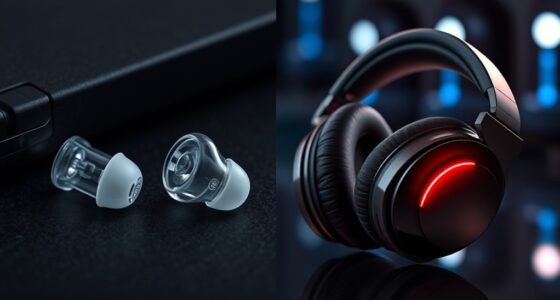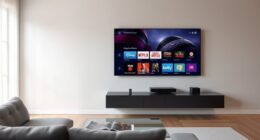Bone conduction hearing technology works by transmitting vibrations directly to your inner ear through skull bones, bypassing damaged or blocked parts of the outer or middle ear. It’s especially helpful if you have ear infections, deformities, or sensitivities that make traditional hearing aids difficult. These devices are discreet, user-friendly, and often connect wirelessly to your phone or other devices. Curious about how this innovative solution could benefit you or someone you know? Keep exploring for more insights.
Key Takeaways
- Bone conduction transmits sound vibrations directly through skull bones to the inner ear, bypassing outer and middle ear issues.
- It is especially beneficial for individuals with ear canal deformities, infections, or allergies that hinder traditional hearing aids.
- Devices are compact, externally mounted, and discreet, making them suitable for active lifestyles and comfortable for sensitive skin.
- Wireless Bluetooth connectivity allows streaming audio from smartphones, improving hearing clarity in various environments.
- Bone conduction technology offers an alternative hearing solution for those unable to use conventional air conduction aids.

Have you ever wondered how some hearing aids work even when traditional options aren’t suitable? It’s a fascinating area of audiology that leverages innovative technology to bypass the usual pathways of sound transmission. Instead of relying solely on air conduction, which requires sound waves to travel through the ear canal, bone conduction hearing devices send vibrations directly to your inner ear via your skull bones. This approach transforms hearing aid design by focusing on how sound is delivered through vibrations rather than air. These devices are especially useful for individuals with outer or middle ear problems, such as blockages, deformities, or infections, where conventional hearing aids may not fit comfortably or effectively.
The core of this technology lies in its innovative design that captures sound, converts it into vibrations, and transmits them through the bones. The hearing aid usually consists of a small, discreet device that rests against your skull, often behind the ear, or even on your head or teeth. When you speak or listen, the device picks up sound through a microphone, processes it, and then vibrates in sync with the sound. These vibrations travel through the bones of your skull directly to your cochlea—the sensory organ in your inner ear—bypassing damaged or obstructed parts of your ear canal. This method allows you to perceive sound clearly, even in cases where traditional hearing aids might struggle due to ear shape, size, or medical conditions.
The hearing aid design in bone conduction devices is intentionally compact and user-friendly, emphasizing comfort and ease of use. Unlike traditional hearing aids that fit inside or behind your ear, these devices are mounted externally and often require minimal maintenance. Their design also makes them an excellent choice for individuals with sensitive skin or allergies, as they don’t require inserting anything deep into the ear canal. Additionally, bone conduction technology offers a unique solution for those who need to hear in noisy environments or while engaging in active outdoor activities. The innovation doesn’t stop there; many of these devices now incorporate wireless connectivity, allowing you to stream audio directly from smartphones or other Bluetooth-enabled devices, further enhancing their versatility.
Frequently Asked Questions
Are Bone Conduction Devices Suitable for Children With Hearing Loss?
Yes, bone conduction devices are suitable for children with hearing loss. In pediatric audiology, these devices are often used because they bypass damaged ear parts, providing clearer sound. You should guarantee proper device fitting for your child to maximize comfort and effectiveness. Bone conduction devices are a reliable option, especially for kids with conductive or mixed hearing loss, helping them develop language and communication skills more effectively.
How Long Do Bone Conduction Hearing Devices Typically Last?
Ah, the timeless quest for device durability! Bone conduction hearing devices generally last between 3 to 7 years, depending on how well you treat them. Battery lifespan varies, with most needing replacement every 6 to 12 months. Proper maintenance extends their life, so you’re not left in silence prematurely. Think of it as investing in your auditory future—treat it well, and it’ll serve you longer.
Can Bone Conduction Hearing Aids Be Used During Sports Activities?
Yes, you can use bone conduction hearing aids during sports activities. Many models feature water resistance and are designed for activity compatibility, making them suitable for running, cycling, or swimming. Just guarantee you choose a device with the appropriate water resistance rating for your sport. This way, you can enjoy your activities without worrying about damage, and stay connected with clear hearing even during intense physical movements.
What Maintenance Is Required for Bone Conduction Hearing Devices?
You need to regularly clean your bone conduction device with a soft, damp cloth to prevent buildup and guarantee ideal performance. Check the device for dirt or moisture, and wipe it gently. Battery replacement is also essential; replace the batteries as recommended by your audiologist or when you notice reduced sound quality. Proper maintenance keeps your device functioning effectively and extends its lifespan, ensuring you get the best hearing experience.
Are There Any Risks or Side Effects Associated With Bone Conduction Hearing?
You might experience some risks or side effects with bone conduction hearing devices, like skin irritation where the device contacts your skin, or occasional device malfunction. To minimize these issues, keep the device clean and check for signs of irritation regularly. If you notice persistent discomfort or malfunction, consult your audiologist promptly. Overall, with proper care, these devices are safe and effective for improving your hearing.
Conclusion
Think of bone conduction hearing like a secret tunnel that bypasses the usual obstacles, guiding sound directly to your inner ear. Just as a hidden pathway can reveal treasures, this technology unlocks the world of sound for those with hearing challenges. It’s a remarkable bridge, connecting you to your surroundings in ways you never thought possible. Embrace this innovative tunnel, and let the symphony of life flow through it, transforming how you experience the world around you.











